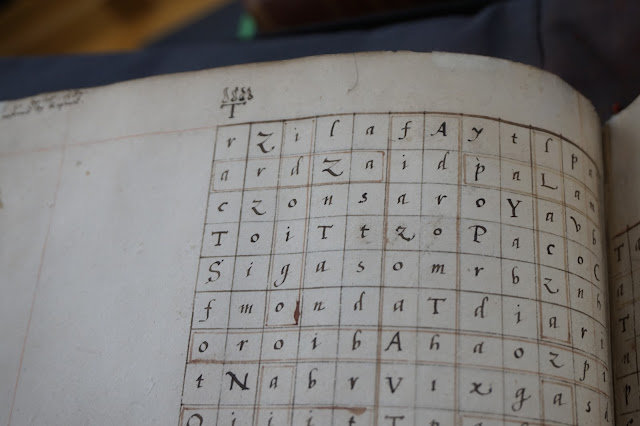Lambeth Palace Library - MS 658 f. 58 - Adam Bacon Papers
The above is a letter to Elizabethan-era spy Anthony Bacon (brother of Sir Francis Bacon) from correspondent H. H. You can see code being used in the 8th line from the bottom in the main body of the text. I imagine this code has to do with political goings-on in other countries rather than communicating about a hidden object, but I thought it would be interesting to share nonetheless. Below is the binding of this volume of Anthony Bacon papers.
British Library - Sloan MS 3679 - Piccatrix
British Library - Sloan MS 3679 - Piccatrix
Tractust de Arte Astrological et Magica - British Museum
The above and blow are from the "long-lost" book of Soyga, which was "rediscovered" in the British Library (another copy found in Oxford's Bodleian) in the 1990s. This book belonged to John Dee, and it was thought that it would shed further light on his communications with angels. I don't know that what we're looking at here involves a code, but the meanings here are certainly hidden from me. The cover is two pictures down. By the way, soyga spelled backwards is agyos or agios, which is Greek for holy.
Tractust de Arte Astrological et Magica - British Museum
Tractust de Arte Astrological et Magica - British Museum
British Library - Claves Angelicae
British Library - Claves Angelicae
British Library - Claves Angelicae
I especially like the ideas of making a grid of letters and then having the decryption involve tracing a path through the letters.
British Library - Claves Angelicae
British Library - Sloan MS 3191 -Claves Angelicae
British Library - Sloane MS 3191 - Claves Angelicae - frontispiece
The codex below contains two works, one of which is one of which is a book on encryption by Jacopo Silvestri. It was the second book printed on the topic of encryption (1526). John Dee purchased this book in Venice in 1563, as you can see noted in his own handwriting in the second picture below.
 |
| British Library - 8405.a.9. - Silvestri, Jacopo - Opus novum |
 |
| British Library - 8495.a.9 - Silvestri, Jacopo - Opus novum |
 |
| British Library - 8405.a.9 - Silvestri, Jacopo - Opus novum |
The images below are from a book about Dee and his conversations with angels by Meric Casaubon. The grid shown is of the tables or book of Enoch. One of John Dee's goals was to find the language of the angels, the language that was spoken in the Garden of Eden. He communicated with angels in order to try to discern this. It is sometimes called the Enochian Language, though Dee never called it that. Here too I see great ideas for codes.
Bodleian Library - Ashmole 580
Bodleian Library - Ashmole 580
Bodleian Library - Ashmole 580
Bodleian Library - Ashmole 580
The full message says, "This night my wife dreamed that one cam to her and touched her, saying 'Mistres Dee, you are conceived of child, whose name must be Zacharias; be of good chere, he sal do well as this doth!'"
There are two volumes of Dee's diaries in the Bodliean: Ashmole 488 and Ashmole 487. I'm not sure which of the two I was consulting when I took the picture above. I could figure it out give time to look at my pictures and my journal.
There have been codes since time immemorial, going back at least as far as the famous Ceaser Cipher, which is just a letter substitution by shifting the alphabet a space or more down. I imagine most codes have been used for military secrets - or by lovers - or for political intrigue.
I'm only aware of one that has to do with treasure, and that is the Beale Cipher from 1820s America, which can be found at this link: https://www.peaksofotterwinery.com/beale-treasure-codes
There is also a fifteenth-century codex known as the Voynich Manuscript, which no one has been able to decipher, so who knows what secrets that holds! (This is in Yale's collection, and I haven't traveled there yet, despite it being in the US!)




















